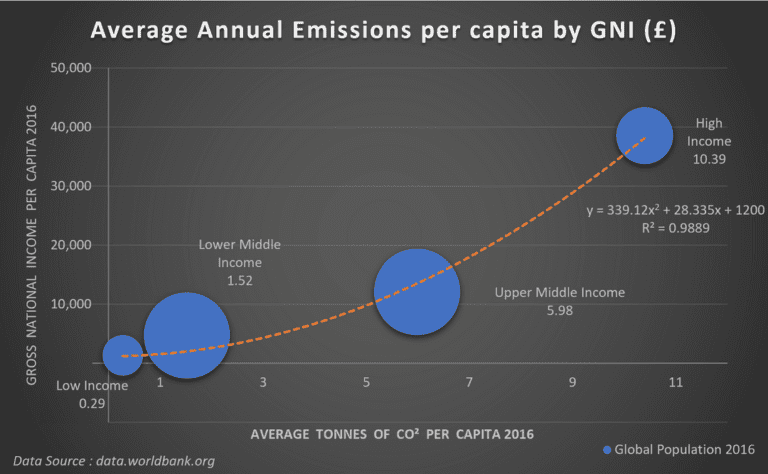We take World Bank Data for carbon emissions and Gross National Income to model the rise in emissions per capita as incomes increase. The graph below demonstrates the underlying assumptions. We use 2016 data for emissions, population and GNI.

Flights
We use the average hourly emissions of a flight from LHR to NYC using the calculator from Atmosfair.de. Long haul flights are typically in the range of 0.185-0.20 tonnes per hour, while short haul flights are typically more efficient in the range of 0.07-0.12 per hour. The World Bank data for emissions per capita based on Gross National Income does not account for any air travel due to the complexities of attributing international travel to a single country. As a result, any flights are added to your carbon footprint.
Transport
Basic public transport is assumed to be included within the income-based calculation of emissions. Regular car travel in addition to public transport is added to your carbon footprint. We use the US Environment Protection Agency estimate of 404 grammes per mile (251 grammes per kilometer) as our basis for calculation.
Diet
We use the coolclimate.org calculator to estimate the difference between a vegan and a meat eater. The difference per year is relatively low, 1.52 tonnes, about the same as a one way transatlantic flight. We set a vegan at 0 tonnes, assuming that the lowest carbon diet is fully accounted for in the income indicator.
The price of carbon offsets is currently TOO LOW to seriously dissuade people from causing emissions. A Meaningful Price means a cost per tonne of CO₂ equivalent that is estimated by economists and scientists to cause a real incentive for businesses and individuals to reduce carbon intensity enough to meet global targets of GHG reduction. While there is debate on what exactly this price might be, the Climate Leadership Council proposes a fee of $40 per tonne on all carbon consumption in the United States, increasing annually by 5%; Switzerland has been implementing such a CO₂ tax which is now charged at CHF96 per tonne ($99) for many types of GHG emitting substances; many other countries are at various stages of developing a carbon tax. For this calculator we set the Meaningful Price at $99 (£80.76) in line with Switzerland as the most established carbon tax so far.





